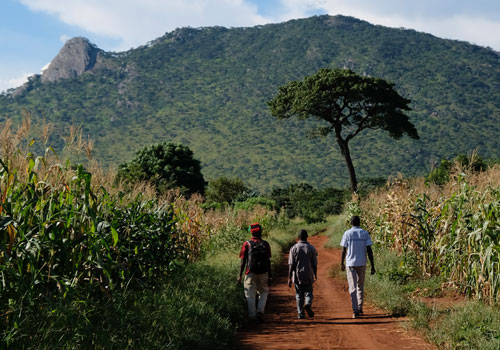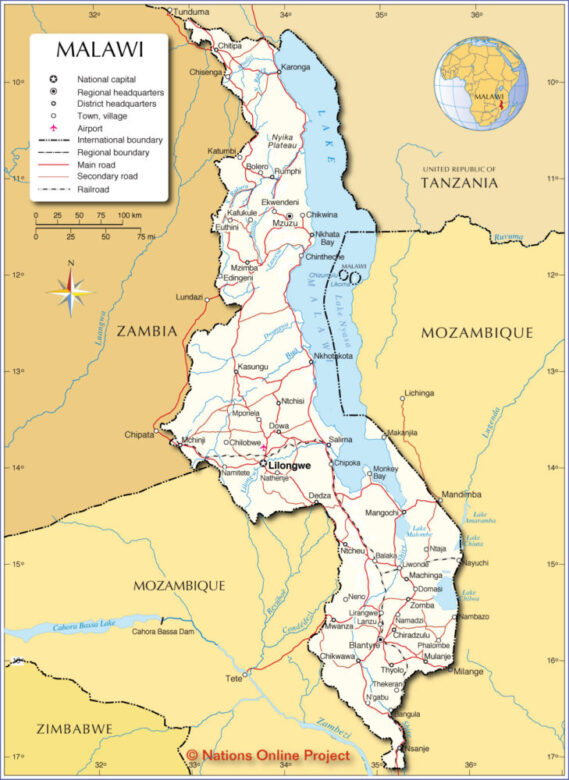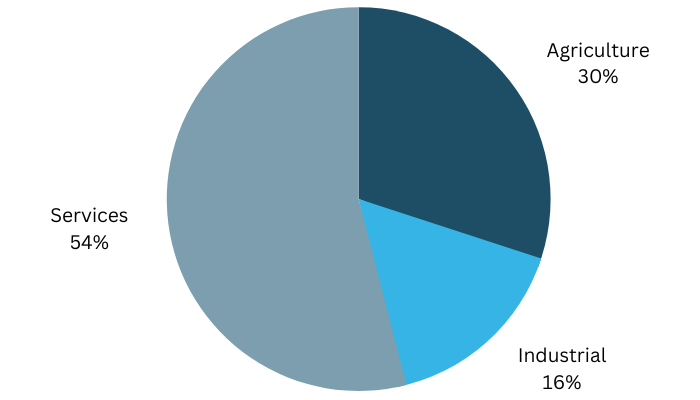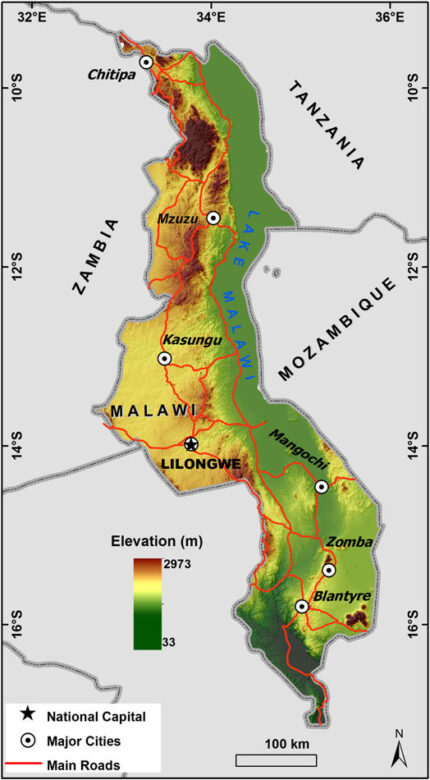About Malawi
The Warm Heart of Africa
Malawi is a country of 19 million people in southeastern Africa. It is famous for the spectacular Lake Malawi and is known as the “The Warm Heart of Africa”.
Malawi is among the world’s least-developed countries with a largely agricultural economy and rural population.

A Brief History of Malawi

Pre-History
The area that is now Malawi has been inhabited by various ethnic groups for thousands of years, with evidence of Homo sapiens dating back to approximately 8000 BCE and evidence of human settlement dating back to the Stone Age. Early tribes were most likely ancestors of the San people, prior to the Bantu invasion of 1200 CE. The most well-known pre-colonial empire in the region was the Maravi Empire, established in 1480, which controlled much of present-day Malawi, Zambia, and Mozambique.
The Maravi Empire
The Maravi Empire was a centralized system of government consisting of related ethnolinguistic groups. It was ruled by a karonga (king), and this authority was passed down through the leaders of each clan within the confederacy. The main portion of this empire settled southwest of Lake Nyasa (Lake Malawi). During the 15th or 16th century, two groups migrated south into the Shire River valley and other groups moved into territories in what are now Zambia and Mozambique. The Maravi Empire reached its peak in the 17th century, administering a large area that stretched north of the Zambezi River to the Dwangwa River, west to the Luangwa River, and east to the Mozambique coast.
Its decline began when clan leaders, who traded with the Portuguese and Arabs in ivory, slaves, and iron, became increasingly independent of the central authority of the karonga. By 1720 the confederacy had broken into several autonomous factions. The Chewa and Nyanja peoples of modern day Malawi are descendants of the original Maravi clans.
Pre-Colonial
The precolonial period witnessed other important developments. In the 18th and 19th centuries, better and more productive agricultural practices were adopted. In some parts of the Malawi region, shifting cultivation of indigenous varieties of millet and sorghum began to give way to more intensive cultivation of crops with a higher carbohydrate content, such as corn (maize), cassava (manioc), and rice.
Islam and Christianity spread into the area in the 1800s, along with ethnic groups fleeing the Zulu states to the south. The slave trade also entered the area in the mid-1800s.
British Colonization
In the late 19th century, the area that is now Malawi was colonized by the British as part of their expansion into Africa. The country was known as Nyasaland and was governed as a British protectorate. During this period, the British introduced cash crops like tea and tobacco, and forced labor was used to build infrastructure like roads and railways.
Independence and the Republic of Malawi
Malawi gained independence from Britain on July 6, 1964, and became a republic in 1966. The first president of Malawi was Dr. Hastings Kamuzu Banda, who ruled the country for 30 years until 1994. During this period, Malawi became a one-party state, with all political opposition banned.
In 1994, Malawi held its first multi-party elections, which were won by Bakili Muluzi of the United Democratic Front (UDF). Muluzi served two terms as president before being succeeded by Bingu wa Mutharika in 2004. Mutharika was re-elected in 2009 but died in office in 2012.
The current president of Malawi is Lazarus Chakwera, who was elected in June 2020. Chakwera defeated the incumbent president, Peter Mutharika, in a re-run of the 2019 presidential election.
In recent years, Malawi has faced a number of challenges, including high rates of poverty and unemployment, environmental degradation, and political instability. However, the country has also made progress in areas like health and education, and has become known for its peaceful and democratic transition of power in 1994 and 2020.
Overall, Malawi has a rich and complex history that reflects the experiences of many African countries, from pre-colonial empires to colonialism and independence, and the ongoing struggles and achievements of the post-colonial era.

Economy of Malawi
Malawi has a Gross Domestic Product (GDP) of US$7.5 billion as of 2020. Malawi is considered to be one of the least developed countries in the world, with a Human Development Index (HDI) ranking of 175 out of 189 countries.

Agricultural Sector
Agriculture is the backbone of Malawi’s economy, employing about 80% of the population and contributing about 30% to the country’s GDP. The main agricultural products in Malawi include tobacco, tea, sugar, cotton, maize, and rice. However, the agriculture sector is vulnerable to weather-related shocks, such as droughts and floods, which can significantly impact agricultural productivity and food security.

Industrial Sector
Malawi’s industrial sector is relatively small, contributing only about 16% to the country’s GDP. The main industries in Malawi include food processing, beverages, tobacco, and textiles. However, the country faces significant challenges in terms of infrastructure, such as electricity and transportation, which can hinder the growth of the industrial sector.
Services Sector
The services sector is the largest contributor to Malawi’s GDP, accounting for about 54% of the total. The main services in Malawi include wholesale and retail trade, transport, and communication. The tourism sector is also an important contributor to the services sector and the economy as a whole, with potential for growth.
Trade
Malawi’s main trading partners include India, South Africa, China, and the United States. The country’s main exports are tobacco, tea, sugar, cotton, and other agricultural products. However, Malawi’s export base is narrow, which makes the economy vulnerable to external shocks and fluctuations in commodity prices.
Economic Challenges
Malawi faces significant economic challenges, including poverty, unemployment, and high inflation. In addition, the country has a high debt burden and has faced challenges in managing its public finances. The COVID-19 pandemic has also had a significant impact on Malawi’s economy, particularly in terms of reduced economic activity and increased government spending on health and social protection.
Politics and Governance of Malawi
Political System
Malawi is a multiparty democracy with a presidential system of government. The President is both head of state and head of government, and is elected to a five-year term through a two-round electoral system. The National Assembly is the legislative arm of the government and is made up of 193 members, with 28 seats reserved for women.
Political Issues & Challenges
Malawi faces a number of political challenges, including corruption, poverty, and human rights abuses. Corruption is widespread, with politicians and government officials often accused of embezzlement and misuse of public funds. Poverty and inequality are also major issues, with Malawi ranking among the world’s poorest countries. In addition, human rights abuses such as extrajudicial killings and restrictions on freedom of speech and assembly have been reported.
Major Political Parties
The two major political parties in Malawi are the ruling Democratic Progressive Party (DPP) and the opposition Malawi Congress Party (MCP). Other notable parties include the United Democratic Front (UDF), which was in a coalition with the DPP, and the newly formed United Transformation Movement (UTM).
Recent Political Developments
In May 2020, Malawi held a historic presidential election rerun after the 2019 election was nullified by the Constitutional Court due to irregularities. Opposition leader Lazarus Chakwera of the MCP won the election, defeating incumbent President Peter Mutharika of the DPP. The election was seen as a victory for democracy and transparency in Malawi, as it marked the first time in African history that a court-ordered election rerun resulted in the defeat of an incumbent president.
Since the election, there have been some positive political developments, including efforts to combat corruption and improve human rights. However, the new government faces significant challenges in addressing the country’s poverty and inequality, as well as improving access to healthcare, education, and other essential services.
Culture of Malawi
The culture of Malawi is diverse and influenced by a variety of factors, including the country’s history, geography, and ethnic groups. Malawi has a population of over 19 million people, and is home to several ethnic groups, including the Chewa, Nyanja, Tumbuka, Yao, and Lomwe, among others. While each of these groups has their own unique traditions and customs, there are some common cultural features that can be found throughout the country.
The official languages of Malawi are English and Chichewa. English is the language of government, business, and education, while Chichewa is the most widely spoken language in the country. Other languages spoken in Malawi include Tumbuka, Yao, and Lomwe.
One of the most important cultural practices in Malawi is music and dance. Music is an integral part of daily life, and is often used in social, religious, and political contexts. Traditional music is typically performed using a variety of instruments, including drums, xylophones, and rattles, and often involves call-and-response singing.
Another important aspect of Malawian culture is traditional dress. Many ethnic groups have their own unique styles of dress, with brightly colored fabrics and intricate patterns. Traditional dress is often worn during cultural ceremonies and festivals, such as weddings and initiation ceremonies.
Religion also plays an important role in Malawian culture, with the majority of the population identifying as Christian or Muslim. Traditional beliefs and practices are also common, particularly in rural areas.
In addition to these cultural practices, Malawi is also known for its arts and crafts, including woodcarving, basket weaving, and pottery. These crafts are often used to create functional objects like baskets and pots, as well as decorative pieces like masks and sculptures.
Geography of Malawi
Malawi is a landlocked country in southeastern Africa, bordered by Tanzania to the northeast, Mozambique to the east, south, and southwest, and Zambia to the northwest. The country covers an area of approximately 118,480 square kilometers, making it the 98th largest country in the world. Malawi is divided into three regions: the Northern Region, the Central Region, and the Southern Region.
Landforms
Malawi is characterized by a plateau that rises from the eastern coast of Africa and is separated by the Great Rift Valley. The highest point in Malawi is Sapitwa Peak, which stands at 3,002 meters above sea level and is located in the Mulanje Massif in the Southern Region. The country is also home to Lake Malawi, which is one of the largest lakes in Africa and the third-largest lake on the continent. Lake Malawi is a major source of fish and water for the country and is also a popular tourist destination.
Climate
Malawi has a tropical climate with two distinct seasons: a rainy season from November to April and a dry season from May to October. The country experiences high temperatures throughout the year, with average temperatures ranging from 20°C to 30°C. The northern region of Malawi is generally cooler and has a more temperate climate, while the southern region is warmer and drier.
Environmental Issues
Malawi faces a range of environmental issues, including deforestation, soil erosion, and water pollution. The country has also experienced droughts and floods, which have had significant impacts on agricultural productivity and food security. In addition, the rapid expansion of the population and the resulting increase in demand for land and resources has put pressure on the country’s natural environment.
Natural Resources
Malawi has a variety of natural resources, including arable land, water, forests, and minerals. The country’s main mineral resources include uranium, coal, bauxite, and rare earth minerals, although the mining sector in Malawi is underdeveloped.

References
“Culture of Malawi,” Countries and Their Cultures
“History of Malawi,” Encyclopedia Brittanica
“Malawi: Culture,” Encyclopædia Britannica
“Malawi: Government and History,” Encyclopædia Britannica
“Malawi,” U.S. Department of State
